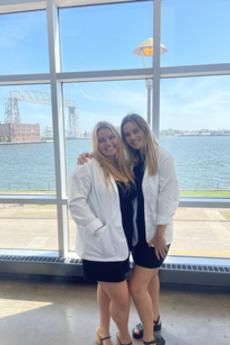
Author: Erin Wilson | August 6, 2024
Lauren Ganske and her younger sister Rachel have just wrapped up their respective years of the PharmD program, but they’ve experienced pharmacy school through two different curricula. Lauren, now preparing for her fourth year, has learned through the CI-1 curriculum, while Rachel, about to enter her second year, is part of the first cohort of PharmD students participating in the new MNspire curriculum. Hearing about Rachel’s experience has given Lauren insight on the transition from the former curriculum to MNspire.
She describes her CI-1 curriculum as “much more of a traditional semester basis coursework” with six to eight individual courses at a time, while Rachel’s resembles one similar to a medical school with a block setup. MNspire students complete a mini semester, finish with a final, and move on to rotations for the break in between before starting a second block. As opposed to CI-1’s break in the middle of the term, MNspire’s block system allows for a more ergonomic approach.
“It could be kind of challenging because faculty have to find a semi-appropriate pausing point… and then you basically are restarting all the gears after two weeks off and it can be a little disjointed,” Lauren said. “So the switch to the block setup was basically to help close a chapter before you take time off. So in Rachel's curriculum, unlike mine, they're basically taking one block and that's the meat and potatoes of the content.”
It also eases the chaos of midterms and finals scheduling. Rather than working around four or more finals in one week, like Lauren’s most recent week of exams, MNspire students have to study for just one comprehensive exam. She added that the more consistent weekly schedule of four days on campus and one asynchronous study day is more conducive to productivity and less stress.
“There's more cohesion to all the content that's being taught, so it allows for less overall stress… it's all mapped within one course, instead of having a ton of people all planning different things… by merging it all together, it kind of reduces the scheduling conflicts a little bit,” Lauren said. “[Rachel] had a lot of eggs in one basket, which is a different type of stress.”
Another major improvement Lauren noted was MNspire’s way of integrating clinical content earlier on in the program. She said memorization only goes so far and taking clinical courses early on exposes students to patients who don’t follow an exact algorithm, helping them learn to think critically during real-world patient care.
“There are some pieces [to the new curriculum] where I thought ‘whoa, that's really great, and I wish that I would have had access to that,’” Lauren said. “The goal is for students to start thinking more like a pharmacist sooner, rather than doing heavy memorization…I think they've really gotten to that core of how we can teach you the skills of being a really strong foundational pharmacist…it's much more holistic,” she said.
Overall, Lauren feels MNspire is an improvement to the pharmacy student experience, though there are “bumps in the roads that have to be ironed out with any new curriculum,” like discerning how much weight to assign to different units of content.
“It is a really good mix of still keeping the very positive and good parts of our curriculum, but reframing them,” she said. “Because the role of a pharmacist has changed a lot in the last 10 to 15 years, so it’s important to keep up with the demands of what we need people to be able to do when they graduate.”
In terms of personal and professional development, Lauren said she believes most of the important elements of skill development available throughout her curriculum will persist in the new one— public speaking, networking, professional organizations, etcetera.
Two changes she thinks might go under-appreciated by MNspire students are the exam schedule and the value of in-person learning.
“Our cohort has told the current second years, ‘You guys, I get it's stressful, but you don't even know what it was like,’” she said. “There's probably a surrogate stress marker that they've experienced in place of that but I think hands down it's the scheduling and cross communication.”
The MNspire curriculum has also helped the college start from scratch with expectations about learning on-site, Lauren said. Her experience was much more hybrid, due to both COVID-19 and “the Pandora's box that we opened'' because of it, she said.
“They're getting people back in the classroom and really setting the bar,” she said. “I think peer-to-peer learning is so valuable and people don't realize it because they're much more comfortable at home, which is fair, I am too— but you don’t realize how much you learn and how much better you learn when you actually show up.”